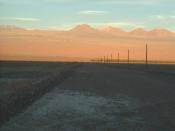Today's global situation is one diametrically different form that of a century ago, the politics and economics of globalization have driven the world to mold into regional blocs of interests and interdependence among nations, which has unequivocally traduced in these last years, in that no conflict between nations falls "beyond the reach of the International Community" (Calvert, 76), especially if it poses a threat to the existent peace milieu, principally in the south American region.
The following analysis will attempt to objectify the boundary conflict between Bolivia and Chile. Although the Bolivian claim of right to access coasts that have been lost to Chile for more than one hundred years, the new ideals of continental integration and the desire to create more solid routes of economic channels, Bolivian claims of sovereign access to the Pacific have gained steam in International Forums. The repercussions of access to the Pacific, by Bolivia, would be momentous not only for this severely underdeveloped nation but also to international law as it makes way for greater cooperation and understanding amongst brother nations.
Prior to the 20th century the Bolivian territory extended to the Pacific and included most of the coast of the Atacama Desert and the port of Antofagasta. The discovery of rich nitrate deposits in the Atacama desert and rising border tensions led the outbreak of war between Chile and Bolivia (1879-1883) (Querejazu) Chile's victory in this war resulted in Bolivia's loss of its outlet to the Pacific (400 km of coastline), along with 158.000 sq. km. of territory (Perez del Castillo, 12). Efforts, mainly political, to regain some outlet to the sea failed. And a revision of the resulting treaty, after the war, (Tratado de Paz y Amistad y LÃÂmites) that has existed since the year 1904, has been requested by Bolivia on...


